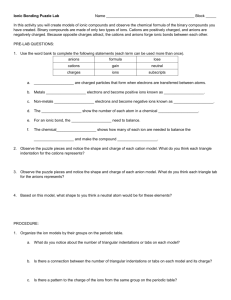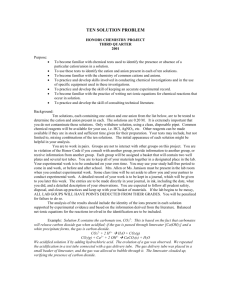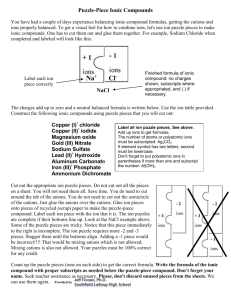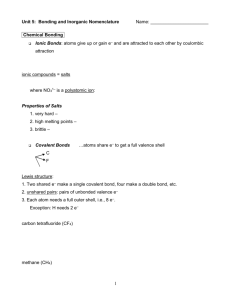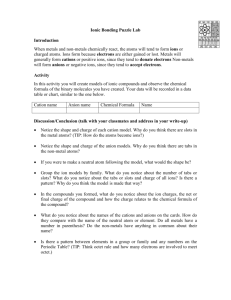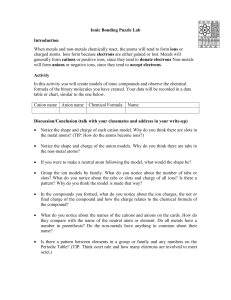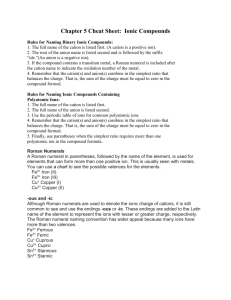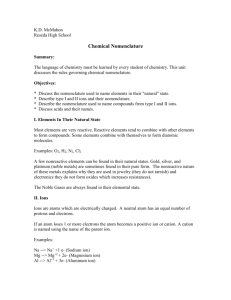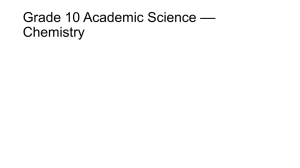Ionic Compounds Puzzle - Chemistry Ms. McChesney
advertisement
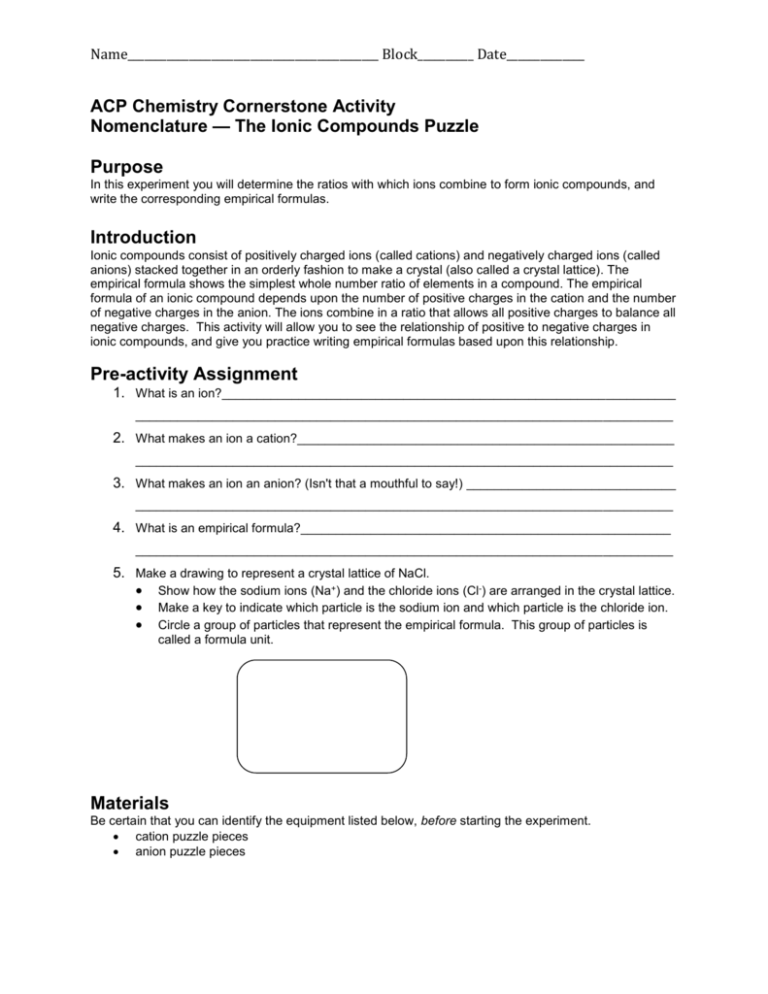
Name_____________________________________________ Block__________ Date______________ ACP Chemistry Cornerstone Activity Nomenclature — The Ionic Compounds Puzzle Purpose In this experiment you will determine the ratios with which ions combine to form ionic compounds, and write the corresponding empirical formulas. Introduction Ionic compounds consist of positively charged ions (called cations) and negatively charged ions (called anions) stacked together in an orderly fashion to make a crystal (also called a crystal lattice). The empirical formula shows the simplest whole number ratio of elements in a compound. The empirical formula of an ionic compound depends upon the number of positive charges in the cation and the number of negative charges in the anion. The ions combine in a ratio that allows all positive charges to balance all negative charges. This activity will allow you to see the relationship of positive to negative charges in ionic compounds, and give you practice writing empirical formulas based upon this relationship. Pre-activity Assignment 1. What is an ion?_________________________________________________________________ _____________________________________________________________________________ 2. What makes an ion a cation?______________________________________________________ _____________________________________________________________________________ 3. What makes an ion an anion? (Isn't that a mouthful to say!) ______________________________ _____________________________________________________________________________ 4. What is an empirical formula?_____________________________________________________ _____________________________________________________________________________ 5. Make a drawing to represent a crystal lattice of NaCl. Show how the sodium ions (Na+) and the chloride ions (Cl-) are arranged in the crystal lattice. Make a key to indicate which particle is the sodium ion and which particle is the chloride ion. Circle a group of particles that represent the empirical formula. This group of particles is called a formula unit. Materials Be certain that you can identify the equipment listed below, before starting the experiment. cation puzzle pieces anion puzzle pieces Name_____________________________________________ Block__________ Date______________ Procedure Part A. Solving the Puzzles! 1. Organize the cation puzzle pieces into stacks of the same cation. (All the sodium ions in one stack, all the aluminum ions in another stack, etc.) 2. Organize the anion puzzle pieces into stacks of the same anion. 3. The data table is arranged in a 5 x 5 matrix to give 25 different combinations of cations and anions. Use the ion puzzle pieces to make each of the compounds in the 5 x 5 matrix. Model the charge balancing by placing the puzzle pieces together such that each positive charge (+) from a cation neighbors a negative charge (-) from an anion. You may need more than one cation and/or anion to achieve this. Every completed ionic compound puzzle will be a rectangle, if you correctly balance charges. Ca 2+ calcium + Br bromide For example, + The empirical formula is CaBr2. - Br - bromide The compound name is calcium bromide. 4. In each box, write the compound name and the empirical formula. To write the formula for each ionic compound: Write the formula for the cation, leaving out the charge. Write a subscript for the number of cations required for the model. Write the formula for the anion, leaving out the charge. Write a subscript for the number of anions required in the model. Use parentheses for polyatomic ions if more than one is needed. Part A. Data Table anions Ffluoride cations Na+ sodium Al3+ aluminum Pb4+ lead (IV) Pb2+ lead (II) NH4+ Ammonium O2oxide N3nitride NO3 nitrate SO3 2sulfite Name_____________________________________________ Block__________ Date______________ Part B. Designing the Matrix This time you are given some of the names and empirical formulas. It will be your job to determine which ions are used to design the matrix. 1. Write the name and formula (including the charge) of all of the cations in the far left hand column. 2. Write the name and formula (including the charge) of all of the anions in the top row. 3. Fill in all of the boxes with the correct name and formula of the compounds made by combining the cations and anions. Draw puzzle pieces if it makes it easier for you to determine the ratio needed to get an overall neutral compound. Part B. Data Table anions cations KCl potassium chloride Ca(C2H3O2)2 calcium acetate Fe(OH)3 iron (III) hydroxide FeSO4 iron (II) sulfate Cu3PO4 copper (I) phosphate Name_____________________________________________ Block__________ Date______________ Post-activity Questions. 1. What is a monatomic ion? Give three examples. ______________________________________ _____________________________________________________________________________ 2. What is a polyatomic ion? Give three examples. _______________________________________ _____________________________________________________________________________ 3. What makes an ionic compound’s charge neutral? Make a drawing to support your answer. ________________________________________ ________________________________________ ________________________________________ 4. What type of solids do ionic compounds make? Draw a picture to support your answer. ________________________________________ ________________________________________ ________________________________________ 5. Why do ionic compounds have empirical formulas and not molecular formulas? (Hint: Think about the difference between an empirical formula and a molecular formula.) _____________________________________________________________________________ _____________________________________________________________________________ _____________________________________________________________________________ 6. Do you expect lead (II) chloride and lead (IV) chloride to have identical, similar, or completely different chemical properties? Explain. _____________________________________________________________________________ _____________________________________________________________________________ _____________________________________________________________________________ _____________________________________________________________________________ _____________________________________________________________________________
